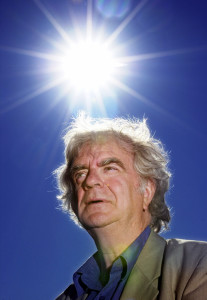(THIS ARTICLE IS MACHINE TRANSLATED by Google from Norwegian)

What can be said about the Norwegian essay – both the informal essay in a Montagueian tradition, and the more formal, non-prosaic essay that may be reminiscent of an academic chronicle or article – since it is almost non-existent, or at least it was, before the on-going Bergensian Georg Johannesen took the magazine from his mouth and got his then publisher Gyldendal to publish his compiled essays: About the Norwegian way of thinking (1975)? A few years later came About the Norwegian way of writing (1981), and in 1976 came Jan Erik Volds Enthusiastic essays. All three came out on Gyldendal's Torch Books, and then Gyldendal was at the forefront, so to speak.

After Johannesen and Vold came a number of "profile authors" with their essays, because in many ways the modern Norwegian essay is included in journals. Since the Norwegian newspapers have a weak intellectual habitus, the magazines took over, and they continue to take over (even now, with Klassekampen as something completely unique in Norwegian press history, and the weekly newspapers Morgenbladet and Dag & Tid, not to forget the monthly newspaper Ny Tid), with magazines such as Vinduet, Vagant and Agora (more on that later). In many ways, these are the backbone of the Norwegian intellectual way of writing and thinking.
That was the window during Jan Kjærstad's editorial period which made me start writing essays. At the end of his editorial career came Kjærstad's first collection of essays The matrix of man (which is more towards the formal essay) in 1989, and the same year Jon Fosse joined From counting through showing to writing (and it has in common with Kjærstad that this is more formal poetics than informal essays). The following year came my first essay collection 4th person singular.
Before my male colleagues, the enterprising Karin Moe – my generation's best head – was out with his first essay collection in 1986 (Genre), and to make a jump: In 1991 Freddy Fjellheim came up with his essay collection compounds, transcripts, sermons, essays, stories – and then, as if someone pulled out a small plug, Stig Sæterbakken came along Aesthetic bliss (1994), Arild Linneberg with Bastard Attempts (1994), Svein Jarvoll co Melbourn lectures (1995), Helge Torvund with Hopelessly in love with their own skeleton (1995), Geir Gulliksen with Reality and other essays (1996), Kjartan Fløgstad with anti Poder (1996), Espen Haavardsholm with Essays in selection (1996), Solveig Aareskjold with Kiss me in the discourse (1996), and so on.

But this is not intended to be a Norwegian essay story. It is the young writers who write essays now, both informal and formal, I want to write about – not to disguise Solstad (who manages to be the piece of art to be remembered through all generations), Økland (who writes commissioned prose), Violence ( who continues to be enthusiastic) or Fløgstad (and his polemical case prose), not to forget the clueless Johannes who published several essay books on Cappelen after his Gyldendal exit.
I must mention the great foreword Gordon Hølmebakk has written to many authors' short stories (which he himself has collected); Sven Kærup Bjørneboe writes almost only essays, and for many years he has been alone about it, but I do not know if his essay is formal or informal, or rather a self-produced variant.
The young-old Henning Hagerup published his first essay collection winter Notes in 1998, and now just his second essay collection Metaphysical scrap iron, and with his position as one of the strong, self-thinking critics in the country, he is a reference point for the younger writers who are passionate about writing essays, and with the magazines Window and Vagant – as the leaders, where the Book Friend comes a long way, and where Agora is in her own division, incomparable, and then all the independent magazines like Au petit Garage, Lasso, Bøygen, Fanfare, etc. – there is an opening for Mazdak Shafieian and Sigurd Tenningen, to name a few young people, without my care me about age (the first two did not, for incomprehensible reasons, not be included in the Morgenblad list of the top ten author under 35), just about a genre essay. (In parentheses, Kari Løvaas is good at writing essays, as is Per Qvale with her mini-essays, and the rhyme and long-poet poet Øyvind Rimbereid's case prose).
It is the young writers who write essays now, both informal and formal, I want to write about.

After all, it's the Window (when Jan Kjærstad was the editor of Audun Vinger, Kaja Mollerin and now the sharp-coded Preben Jordal) and Vagant (all by himself is Audun Lindholm as editor, and a whole bunch of writers and critics have been in Vagant; Henning Hagerup, Tone Hødnebø, Arve Kleiva, Pål Norheim, Susanne Christensen, Alf van der Hagen, Johann Grip, Torunn Borge, Espen Stueland) who have been a mentor for the young Norwegian essay, not to forget the Shafieians and the editor of the Draft Morten Moi at Gyldendal .
Pål Norheim's latest Book updates (2014) are original ongoing comments from Facebook, which translates to a book becoming a multi-site diary from Eidsvågneset, Oslo, Egypt, Tunis, Marrakech – often with the dry wit of aphorism and the charming lightness of the cage. This is written on the train November 17, 2013: «WHY FACEBOOK IS REACTIONARY? Because (by closer reflection) it is not so much a vital extension of the public as it is the nation's new nervous system, susceptible to all kinds of annoyances. More Pavlov than Plato, more whisper of blood than Kant and Habermas, more enchantment than thought. In summary: One percent reflection; ninety percent reactive, spontaneous impulses and digital wood stove. ”
Tor Eystein Øverås has in the books Life! The literature! (2009) In this landscape (2012) and What is an essay? (2014) was concerned with the essay, but it is as a critic (in Morgenbladet and Klassekampen – he became the critic of the year in 2009; he has also been editor of the Window 1998/1999) I know him best and who has consistently written many travel- essays letter to the Window. He writes well, and it seems that he has a big project – to travel around the world.

Mazdak Shafieian debuted in 2006 with the collection of poems Animal Burial Dark, in 2011 came the collection of poems Antwerp, and this year came the essay collection The ancient material. He has also been editor (together with Sigurd Tenningen) for the journal Au petit Garage, and editor (with Jørn Sværen) for the anthology Theology (2012); what is the thread of the essay collection (where he discusses and writes about various authors – everything from Svein Jarvoll, Sadegh Hedajats, Elsa Gress, Mahmoud Dowlatabadi, Gisle Selnes and so on) is the literary canon, and what kind of memory forms the canon, and not for no reason does he refer to Harald Bloom's book The literary canon of the West – and what is the hub of the floral canon is William Shakespeare, and his solar system, which soon all important writers hover around.
Shafieian has his house gods (who doesn't – Bloom thinks that all writers stand on each other's shoulders, as Joyce is inconceivable without old William) – and he's good at digging out the experience rooms in the books he writes about. He is simply a young writer who reads well and can think: "Rather than being a bishopric or yardstick, the essay must therefore be a walking stick – the emblem of a way of thinking that not only considers history as a book without pagination, but who also understands the writing culture as a series of books in constant danger of being transformed into other books: Here you water the other's flowers and care for the other's farm, while the plants in your own garden turn out in full bloom. ”
The plants "that bloom in full bloom" without being watered, but which are almost self-watering, must be Dowlatabadi's books, as he is controversial in Iran, especially his trilogy from 1990-2000 The old people lived lives, which "despite its linguistic abundance for 20 years has been ignored by Iranian critics". Shafieian parallels Dowlatabadi with Walter Benjamin: "That is why Dowlatabadi – like a Benjamin – is constantly looking to reveal individual events and images that are half-hidden in the dark room of memory, in the hope of producing a single light, an explanation light, while the overall picture of the dangers of the past, and then disappear into the many holes of memory. "

Sigurd Ignition debuted with the short story collection Gaea (2007), then come woven (2010), and this year came the essay collection The triumph of vegetation is total at Gyldendal. Ignition is part of the editorial board of Vagant and is a critic in Morgenbladet; in the preface he writes: "The essays in this book are based on a simple assertion, namely that art is the place where man becomes visible as nature". Just as fully, I must be able to ask: Where is this nature, or where does it manifest itself as nature? Through several books, The Ignition comes with readings that will make us understand what it is he is trying to tell.
He uses a neologism to emphasize what he thinks about our "made" visible nature: anthropocene – "the man-made age" – and it is precisely the one who falls after giving the earth its clear imprint. According to Dietmar Dath and in the novel The abolition of the species humanity is a laid-back stage. Ignition writes: “The novel begins with a conversation between the eye-watcher Philomena and 'the learned', apricot-scented bat Izquierda. As they watch a film about mushroom formation, the female friends discuss the human race finally in the "vegetative phase" life cycle. "
Why is anthropocene the manifestation of our nature? As if the invention of binoculars, microscopes, electroscopes, thermodynamics, synthetic biology, nanotechnology, genetics is our nature, and with an "anthropocentric" imprint the world goes to the dogs since we, according to Peter Sloterdijk, fail as animals; our character seems to be constantly inept, and our ineptitude causes us to invent what causes harm to the animal world.
Hence the title of the book The triumph of vegetation is total. It is the plant kingdom that takes over (and what happens to the animals, since Kafka once claimed that there was hope for the animals, but not for us), because we do not have the nature of the animals, if we have any nature at all; neurobiology Alain Prochiantz writes in Agora (1–2015) that sapiens are "by nature a non-nature" – he believes that our brain at 1400 cubic centimeters is 900 too much, we could have managed with 500. So maybe Sloterdijk is right, and thus also the Ignition: We are unnatural.
This outline is a bit arbitrary (or unnatural, to be in the prochiantzse terminology); There are many I could have mentioned, but it doesn't strike the clear line from the journals to the writers who write essays now. It also doesn't bother the three authors that I believe shines on the Norwegian essay heaven right now, and then I do not distinguish between the informal or the formal; Hagerup, Shafieian and Tenningen blend these essayistic approaches and manage to think on their own. That is where their strength lies, or to say the same with Arthur Schopenhauer (paragraph 270 of the book About the good and the bad): «But it is still only that which one has first thought only for himself, which has real value. Namely, one can divide the thinkers into those who primarily think for themselves and into those who immediately do it for others. The first are the real […] ».
See https://www.nytid.no/om-norske-essayister/ by Truls Lie from June 2015.
Healthy is an essayist and author.


